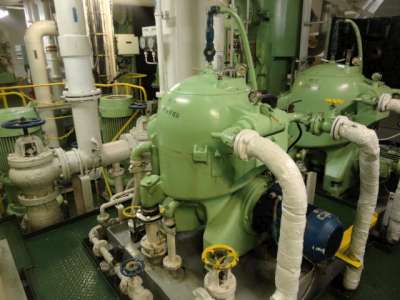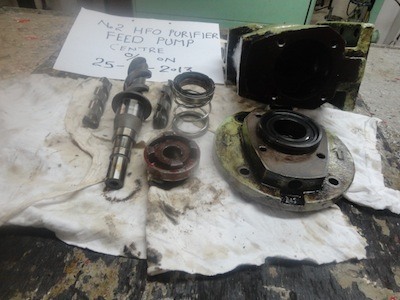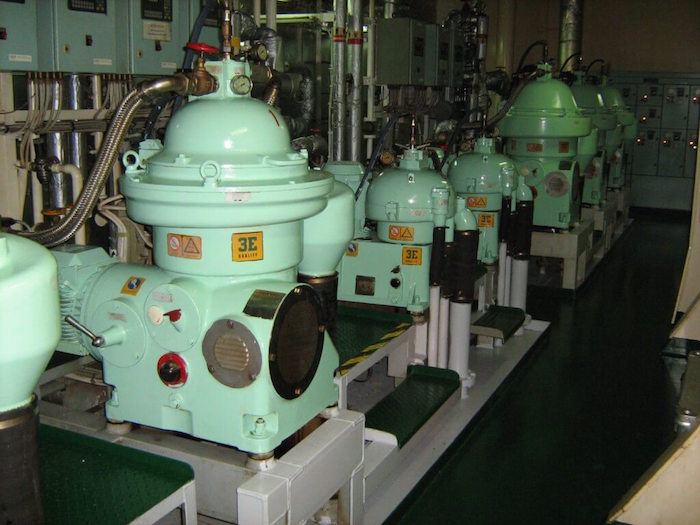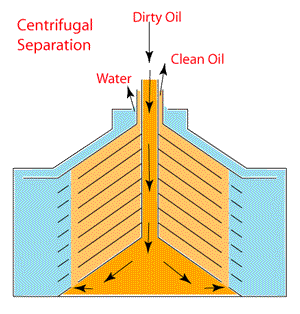

A high-speed centrifuge is a type of separator which is used on a ship to remove contamination from liquids such as fuel and lube oils. It is imperative to carry out this treatment in order to remove solid impurities and water before they are supplied to the marine engine. Thus, the task of the centrifuge is to remove solid contamination from liquid and to remove undesirable liquid (water) from useful liquids (fuel).
The separation principle of high-speed centrifuge depends on the difference in the specific gravity of two different liquids. To understand, let’s take a settling tank where fuel is stored and because of the difference in the gravity of water and fuel (water is heavier) the water gets collected at the bottom part of the due to the effect of gravity.


Fs = ∏/6x D3 (ρw-ρo) g
Where Fs is the separating force, ρw is the density of water, ρo is the density of oil and “g” is gravitational force.
Now if we convert the tank into a conical rotating object, then the gravitational factor g will be replaced by the centrifugal force ω2 r, where ω2 is angular velocity of rotation and r is the effective radius.
Fs = ∏/6x D3 (ρw-ρo) ω2 r.
Now the separating force will be much higher in the centrifuge as compare to a settling tank.
Basic components of the centrifuge are as follows:
The exterior framework is normally made up of cast iron which supports the internal bowl and disk parts and carries water line, feed line, and outlet line connections.
There are bowls inside the frame, which can be a solid assembly operating noncontinuous and have space enough to retain the separated sludge. There can also be an arrangement in which the upper and lower parts are separated for discharging the accumulated sludge by a continuous operation. These parts are normally made up of high tension stainless steel.
The Vertical shaft is used to transform the electrical motor output into rotational motion for rotating the bowl at high speed through spur gear and horizontal shaft or belt. The material used for vertical shaft construction is an alloy of steel.
A general construction of centrifuge consists of a horizontal shaft driven attached supply or discharge gear pump.


In some system, an external supply pump may be installed in place of the attached pump.
The electrical motor drives the horizontal shaft through clutch pads and is used for transmitting the rotational motion to bowl assembly.
A special belt having elastic character is used in some models in place of horizontal shaft, thus removing the use of the gear assembly. The horizontal shaft material is a special alloy of steel.
A spur gear is placed between the horizontal and vertical shafts for the transfer of rotational motion. These gears are manufactured from the special aluminum bronze material.
An electric motor will get overloaded if it is connected directly to the bowl assembly for the rotation of the same as the complete assembly is very heavier. To avoid this, clutch or friction pads and drum assembly are installed on the horizontal shaft. Normally the number of pads varies from 2 to 4 depending upon the frequency supply to the motor
As the motor starts, the pads inside the drum moves out gradually due to centrifugal force and cause friction in the internal wall of the drum resulting in rotation of the shaft and the bowl gradually without overloading and damaging the motor and gears.
Apart from the mechanical parts, the latest centrifuge comes with full automation circuit involving three-way valves, detectors, monitors, transducers, solenoid valves, pneumatic valves etc, along with a control panel, which ensures the centrifuge fulfills all the criteria required for operation in an unmanned engine room.


There are normally two types based on the application:
1) Purifier: When a centrifuge is arranged for separating two liquids of different densities, for e.g. water from oil, it is known as a purifier. The main component of purifier is correct size gravity disc or dam ring which is responsible for creating an interface between the oil and water.
2) Clarifier: When a centrifugal is arranged to remove only impurities and a small amount of water, it is called as the clarifier. Since it is used mainly for that fluid were mostly solid impurities are to be removed, gravity disc is not used in clarifier; instead a sealing ring is used to keep the impurities intact unless desludged.
– It contains a stack of disk numbering up to 150 and is separated from each other by a very small gap. A series of holes are aligned in each disk near the outside edge which permits the entry of dirty oil.


– Due to the difference in gravity and centrifugal force, the heavier impure liquid (water) and particles move outside and lighter clean oil flows inwards and gets separated.
– The collected sludge and impurity can be discharged continuously or at a time intervals, depending upon the construction, automation, and system incorporated
– In a purifier, before introducing the oil, water sealing is established so that oil fill should not flow out through the heavy liquid outlet
– In clarifier, there is no heavy liquid outlet for discharging separated water hence water sealing is unnecessary
– Feed rate and temperature of the feed is extremely important for purification. For normal oil, one stage purification is enough, but for oil containing heavy sludge or catalyst mixture, multiple purifiers are used in either parallel (preferred) or series to get better results
– The new age purifiers/ clarifiers are automatically desludged at a regular interval (by use of timer and controllers. A discharge detectors on the sludge side monitors the sludge side and provides alarm signal if any abnormality is detected
You may also like to read – What Is Quick Coupling or Quick Connect Coupler?










We believe that knowledge is power, and we’re committed to empowering our readers with the information and resources they need to succeed in the merchant navy industry.
Whether you’re looking for advice on career planning, news and analysis, or just want to connect with other aspiring merchant navy applicants, The Marine Learners is the place to be.